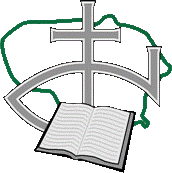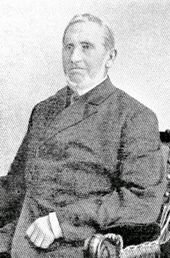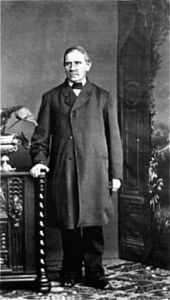Baptists in Lithuania
There is evidence that Baptists in Lithuania have existed since 1841 . Today they are organized in the Lithuanian Union of Evangelical Baptist Congregations (Lithuanian: Lietuvos evangelikų baptistų bendruomenių sąjunga ). The seat of the Lithuanian Baptist Union , one of the small leagues of the European Baptist Federation , is in Klaipėda .
history


The first Baptist baptism that was performed on 16 women in what is now Lithuania (then: Kingdom of Prussia ) in the Dange River is attested to on October 2, 1841. Another baptism of nine men took place the following day. This baptism was followed by the constitution of the Baptist congregation in Memel , which took place under the direction of Johann Gerhard Oncken and was ordained by Eduard Grimm (1808–1874) as the elder of the congregation. In the following years the congregation developed a strong charisma and was, among other things, the nucleus of Latvian Baptism .
prehistory
The cutting mill Eduard Grimm, the aforementioned first elder of the Baptist congregation of Memel, had left his homeland in Memel around 1830 in order to broaden his horizons as a wandering craftsman . He came to Zurich , where he met Samuel Heinrich Fröhlich . Fröhlich, a former pastor of the Reformed State Church , had a free church around him, whose services were also attended by Grimm. Under the impression of the sermon, the Memel craftsmen experienced an inner turn to the Christian faith and was baptized by Fröhlich by pouring over them. After his return to Memelland, Eduard Grimm began holding church service meetings in his apartment from Whitsun 1839, to which he invited friends and colleagues. Despite the resistance of state and church authorities, the circle around Grimm grew. Josef Hague, a former ship's captain from England who retired in Memel, also joined this group. He took the position that the affusion baptism received by Grimm and also practiced by him did not correspond to the New Testament rite of baptism, baptism through immersion . After a period of intensive Bible study , Eduard Grimm and most of his circle gained the same conviction and, on Hague's advice, turned to the Baptist founding fathers Gottfried Wilhelm Lehmann ( Berlin ) and Johann Gerhard Oncken ( Hamburg ). Wanted Oncken himself make their way to Memel, but initially commissioned the Jeveraner Anton Friedrich Remmers to contact Grimm's circle. When Remmers arrived in Memel on August 4, 1841, after an eight-week march, he found around 40 people there who had separated from the regional church. Remmers informed the group about the Baptist understanding of baptism and the congregation , whereupon the desire arose to be baptized again in the New Testament form and to bring an orderly Baptist congregation into being in Memel. On September 30th of the same year Oncken came from Königsberg with a passenger ship to Memel and after a few brief discussions on October 2nd and 3rd, baptized a total of 29 people who, under Oncken's chairmanship, joined together to form the Memel Baptist congregation on the evening of October 3rd .
Further developments
Shortly after the foundation, a violent conflict broke out in the young congregation, as a result of which Grimm and others were excluded from the congregation . They founded another church in Memel. Grimm first went to England and later emigrated with some of his supporters to the United States , where his trail is lost.
Oncken first sent the young preacher Friedrich Oncken to Memel in June 1842, who stayed there for almost half a year to support the weakened and leaderless congregation. At the end of 1842 he returned to Hamburg, but four weeks later set off again on a trip to Memel, this time accompanied by Anton Friedrich Remmers.
literature
- Joseph Lehmann : History of the German Baptists . First part: Education, expansion and persecution of the communities until the dawn of real religious freedom in 1848 . Hamburg 1896, pp. 136-139.
- Rudolf Donat: How the work began. Formation of the German Baptist Churches. According to existing sources and other documents, described by Rudolf Donat . Kassel 1958, pp. 309-322.
- Ian M. Randall: Communities of Conviction. Baptist Beginnings in Europe . Schwarzenfeld 2009, ISBN 978-3-937896-78-6 , pp. 99-110.
Web links
- Daniel Trusiewicz: Baptist beginnings in Lithuania . In: ebf.org , September 23, 2005.
- Official homepage of the Lithuanian Union of Evangelical Baptist Congregations (Lithuanian, Russian, German)
Individual evidence
- ↑ Daniel Trusiewicz: Baptist beginnings in Lithuania . In: ebf.org , September 23, 2005. Retrieved April 11, 2017.
- ↑ Rudolf Donat: How the work began. Formation of the German Baptist Churches. According to existing sources and other documents, described by Rudolf Donat . Kassel 1958, p. 311 f. (That the date given for the church planting October 30, 1841 must be a typographical error is evident from the context.)
- ↑ Rudolf Donat: How the work began. Formation of the German Baptist Churches . Kassel 1958, pp. 309-311.
- ^ Josef Lehmann: History of the German Baptists . First part: Education, expansion and persecution of the communities until the dawn of real religious freedom in 1848 . Hamburg 1896, p. 137.
- ^ Extract from the Journal of Mr. Oncken . In: Massachusetts Baptist Convention, American Baptist Foreign Mission Society (Ed.): The Baptist Missionary Magazine . Volume XXII. Boston 1842, p. 272 f. (Detailed report by Johann Gerhard Onckens about the baptisms and the church planting in Memel; digitized in the Google book search; English).
- ↑ For the exact course of the conflict, see Rudolf Donat: How the work began. Formation of the German Baptist Churches . Kassel 1958, p. 315 f.





